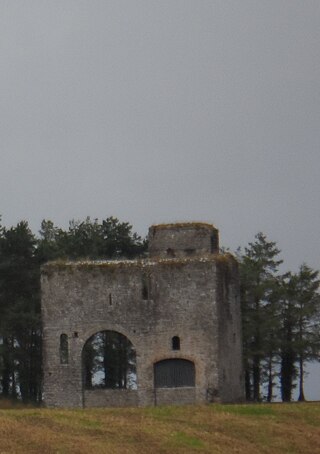The Lord High Chancellor of Ireland was the highest judicial office in Ireland until the establishment of the Irish Free State in 1922. From 1721 to 1801, it was also the highest political office of the Irish Parliament: the Chancellor was Speaker of the Irish House of Lords. The Lord Chancellor was also Lord Keeper of the Great Seal of Ireland. In all three respects, the office mirrored the Lord High Chancellor of Great Britain.

Rowland FitzEustace, 1st Baron Portlester was an Irish peer, statesman and judge. He was one of the dominant political figures in late fifteenth-century Ireland, rivalled in influence probably only by his son-in-law Garret FitzGerald, the "Great" Earl of Kildare.
James Butler, 4th Earl of Ormond was the son of James Butler, 3rd Earl of Ormond. He was called 'The White Earl', and was esteemed for his learning. He was the patron of the Irish literary work, 'The Book of the White Earl'. His career was marked by his long and bitter feud with the Talbot family.

Walter de Lacy was lord of Meath in Ireland. He was also a substantial land owner in Weobley, Herefordshire, in Ludlow, Shropshire, in Ewyas Lacy in the Welsh Marches, and several lands in Normandy. He was the eldest son of Hugh de Lacy, a leading Cambro-Norman baron in the Norman invasion of Ireland, and Rohese of Monmouth.
The Lord High Treasurer of Ireland was the head of the Exchequer of Ireland, and chief financial officer of the Kingdom of Ireland. The designation High was added in 1695.
Thomas Cranley DD a.k.a. Thomas Craule was a leading statesman, judge and cleric in early fifteenth-century Ireland, who held the offices of Chancellor of Oxford University, Archbishop of Dublin and Lord Chancellor of Ireland.

Richard Wogan was an Irish judge and cleric who held the office of Lord Chancellor of Ireland, and also served as a soldier.
Thomas Le Boteller, or Thomas Butler, nicknamed Thomas Bacach i.e. Thomas the Lame, was the illegitimate son of the 3rd Earl of Ormond, and a leading political figure in early fifteenth-century Ireland. He held the offices of Lord Chancellor of Ireland, Lord Deputy of Ireland and Prior of Kilmainham. In his own lifetime, he was a highly unpopular statesman, who was accused by his numerous enemies of treason. He is now chiefly remembered as a professional soldier, who was present at the Siege of Rouen in 1418–19. He had previously fought in the sanguinary conflict known as the Battle of Bloody Bank near Dublin in 1402.
Richard Talbot was an English-born statesman and cleric in fifteenth-century Ireland. He was a younger brother of John Talbot, 1st Earl of Shrewsbury. He held the offices of Archbishop of Dublin and Lord Chancellor of Ireland. He was one of the leading political figures in Ireland for more than thirty years, but his career was marked by controversy and frequent conflicts with other statesmen. In particular, the Talbot brothers' quarrel with the powerful Earl of Ormonde was the main cause of the Butler–Talbot feud, which dominated Irish politics for decades, and seriously weakened the authority of the English Crown in Ireland.
James Cornwalsh was an Irish judge who held the office of Chief Baron of the Irish Exchequer. He was a political figure of considerable importance in fifteenth-century Ireland, and a supporter of the Lord Lieutenant of Ireland, James Butler, 4th Earl of Ormond. He was murdered as a result of a feud over the possession of Baggotrath Castle, near Dublin.
Sir John Cornwalsh, or Cornwalysch was an Irish judge who held the office of Chief Baron of the Irish Exchequer. His tenure was notable for the fact that he succeeded his father as Chief Baron, and for his long struggle to retain the office in defiance of a rival claimant, Michael Gryffin. He is also remembered as the builder of Dardistown Castle in County Meath.
Christopher Bernevall, or Barnewall (1370–1446) was an Irish politician and judge of the fifteenth century, who held the offices of Vice-Treasurer of Ireland and Lord Chief Justice of Ireland. He was deeply involved in the political controversies of his time, and was a leading opponent of the powerful Anglo-Irish magnate James Butler, 4th Earl of Ormond. His elder son Nicholas also held office as Lord Chief Justice, and his younger son Robert was created the first Baron Trimleston.

William Tynbegh, or de Thinbegh (c.1370-1424) was an Irish lawyer who had a long and distinguished career as a judge, holding office as Chief Justice of all three of the courts of common law and as Lord High Treasurer of Ireland. His career is unusual both for the exceptionally young age at which he became a judge, and because left the Bench to become Attorney General for Ireland, but later returned to judicial office.
Nicholas Merbury was an English administrator, Member of Parliament and first Master of the Ordnance.
William Chevir, or Chevyr was an Irish politician and judge, whose career was marked by accusations of oppression and corruption.
Giles Thorndon was a senior official of the English Crown in the fifteenth century, who was noted for his long and loyal service to the House of Lancaster and for his troubled and unsuccessful career as Lord Treasurer of Ireland.
Robert Dyke, Dyck or Dyche was an English-born cleric and judge who held high office in fifteenth-century Ireland. He was appointed to the offices of Archdeacon of Dublin, Chancellor of the Exchequer of Ireland, Lord High Treasurer of Ireland, and Master of the Rolls in Ireland, as well as holding several Church benefices.
Edward Dantsey or Dauntsey was a fifteenth-century Bishop of Meath, who also held high political office in Ireland, serving as Lord High Treasurer of Ireland and twice as Deputy to the Lord Lieutenant of Ireland. In a curious episode in 1426, he was wrongfully charged with theft, but acquitted.




